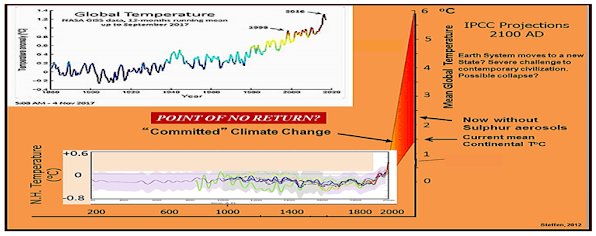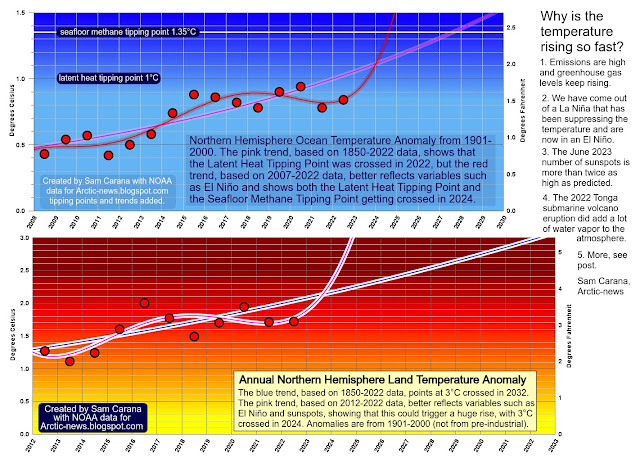by Andrew Glikson
It has been overlooked during Garma festival that, under current policies, global warming would render aboriginal lands in central and northern Australia unliveable and the top-end a nuclear target…
In his classic book The Fate of the Earth speaking for humanity Jonathan Schell describes the horror of a full-scale nuclear holocaust where human beings and animals would die if twenty thousand megatons of bombs, more than a million times the Hiroshima bomb, explode.
The consequences of a global nuclear exchange belong to the unthinkable. Nuclear weapons are the most destructive, inhumane and indiscriminate weapons ever created. Both on the scale of the devastation they cause and uniquely persistent genetically damaging radioactive fallout, they are unlike any other weapons. A single nuclear bomb detonated over a large city could kill millions of people. The use of tens or hundreds of nuclear bombs would disrupt the atmosphere world-wide, causing widespread famine.
 |
| [ Figure 1. Extreme geophysical, meteorological, hydrological and climatological events during 1980 -2012 ] |
From the 1970s the full implications of climate change were only beginning to be realized, through a growing string of cyclones, fires, droughts and floods increasing in frequency and intensity above the recent historical record (Figure 1). At that time few could forecast the climate trajectory like NASA’s chief climate scientist (Hansen et al., 2012), who stated:
“Burning all the fossil fuels would create a different planet than the one that humanity knows. The paleoclimate record and ongoing climate change make it clear that the climate system would be pushed beyond tipping points, setting in motion irreversible changes, including ice sheet disintegration with a continually adjusting shoreline, extermination of a substantial fraction of species on the planet, and increasingly devastating regional climate extremes” and “warming according to the IPCC Business As Usual’ (BAU) scenario would lead to a disastrous multi-meter sea level rise on the century timescale” and “We’ve reached a point where we have a crisis, an emergency, but people don’t know that” ...
 |
| [ Figure 2. credit: NOAA, click on images to enlarge ] |
According to Hans Joachim Schellnhuber, Germany’s chief climate scientist “Climate change is now reaching the end-game, where very soon humanity must choose between taking unprecedented action or accepting that it has been left too late and bear the consequences” …
 |
| [ Figure 3. The five mass extinctions in the Earth’s history. ] |
Within a century or less the Earth’s mean temperature has risen from the mean levels of the Holocene (the last 11,700 years) and the Pleistocene (11,700 years ago to 2.58 million years ago), to levels of the Pliocene (2.58 million years ago to 5.333 million years ago) to the Miocene (5.33 to 23.03 million years ago), 3 - 4°C warmer than the Holocene, at warming rates. This is faster than any identified in the Cenozoic (66 million years until the present) geological record (Glikson, 2022-23). It is difficult to find in the geological record an event increasing the global greenhouse level at a rate as extreme as the current global heating (Figure 4).
 |
| [ Figure 4. Past mean temperatures (200 AD to 2000 AD), current warming and future temperature projections (Steffen, 2012) ] |
An explanation of the collapse of human society, dragging multiple species down with it, arises from Fermi’s Paradox, where the combination of technological achievements and an inherent killer instinct of some leads to collapse.
Books:
The Asteroid Impact Connection of Planetary Evolution
https://www.springer.com/gp/book/9789400763272
The Archaean: Geological and Geochemical Windows into the Early Earth
https://www.springer.com/gp/book/9783319079073
The Plutocene: Blueprints for a Post-Anthropocene Greenhouse Earth
https://www.springer.com/gp/book/9783319572369
The Event Horizon: Homo Prometheus and the Climate Catastrophe
https://www.springer.com/gp/book/9783030547332
Climate, Fire and Human Evolution: The Deep Time Dimensions of the Anthropocene
https://www.springer.com/gp/book/9783319225111
Evolution of the Atmosphere, Fire and the Anthropocene Climate Event Horizon
https://www.springer.com/gp/book/9789400773318
From Stars to Brains: Milestones in the Planetary Evolution of Life and Intelligence
https://www.springer.com/us/book/9783030106027
Asteroids Impacts, Crustal Evolution and Related Mineral Systems with Special Reference to Australia
https://www.springer.com/us/book/9783319745442
The Fatal Species: From Warlike Primates to Planetary Mass Extinction
https://www.springer.com/gp/book/9783030754679
The Trials of Gaia. Milestones in the evolution of Earth with reference to the Antropocene
https://www.amazon.com.au/Trials-Gaia-Milestones-Evolution-Anthropocene/dp/3031237080

































